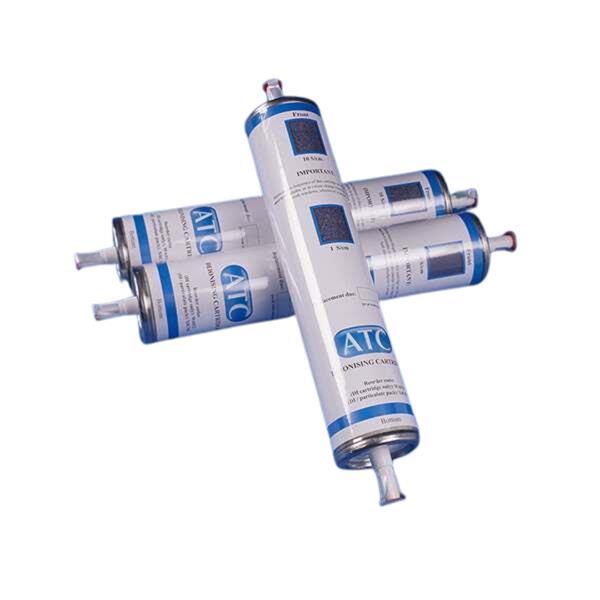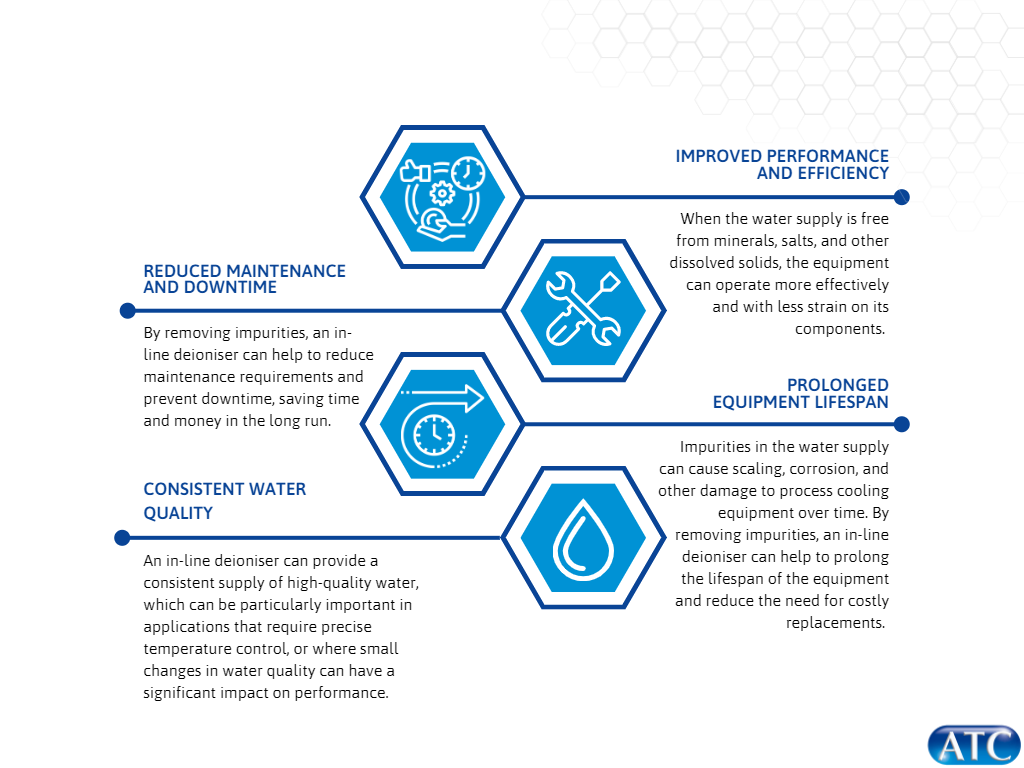
An in-line deioniser is a type of water treatment system
that is often used in process cooling equipment to remove impurities from the
water supply. These impurities can include minerals, salts, and other dissolved
solids that can negatively impact the performance of equipment and cause
problems such as scaling and corrosion.
In-line deionisers work by using a resin bed to remove ions
from the water supply. The resin bed contains positively and negatively charged
resin beads that attract and capture ions as the water passes through. This
process effectively removes impurities and produces high-quality water that is
suitable for use in process cooling.
The resin bed consists of two types of ion exchange resin
beads: cation exchange resin and anion exchange resin.
Cation exchange resin beads are positively charged, and
attract negatively charged ions, such as calcium, magnesium, and sodium. When
water passes through the resin bed, the cation exchange resin beads attract and
capture these negatively charged ions, effectively removing them from the
water.
Anion exchange resin beads, on the other hand, are
negatively charged and attract positively charged ions, such as chloride,
sulphate, and nitrate. As the water passes through the resin bed, the anion
exchange resin beads attract and capture these positively charged ions, further
removing impurities from the water.
The combination of cation and anion exchange resin beads in
the resin bed allows for a highly effective water treatment process, producing
high-quality water that is suitable for use in process cooling.
Over time, as the resin beads become saturated with captured
ions, the effectiveness of the in-line deioniser will decrease. To maintain the
performance of the system the resin bed will need to be regenerated or replaced
periodically, depending on the specific application and usage.
An in-line deioniser can be a useful addition to a chiller
situation in several situations, including:
When the chiller is used in a process that requires high-purity water:
- Some
processes, such as semiconductor manufacturing or pharmaceutical production,
require ultra-pure water with very low levels of impurities. In these
applications, an in-line deioniser can be used to remove impurities from the
water supply before it is used in the chiller.
When the chiller is used in an environment with hard water:
- Hard
water is water that contains high levels of minerals, such as calcium and
magnesium. When hard water is used in a chiller, it can cause scaling and other
problems that can reduce the efficiency and lifespan of the equipment. An
in-line deioniser can be used to remove these minerals from the water supply
and prevent these issues.
When the chiller is used in a location with poor water quality:
- If
the water supply in the location where the chiller is installed has high levels
of impurities or contaminants, an in-line deioniser can be used to remove these
impurities and provide a cleaner source of water for the chiller.
Overall, an in-line deioniser can be a valuable addition to
a system in situation where high-purity water is required, or where the water
supply has high levels of impurities or contaminants that could negatively
impact the performance of equipment.
There are several benefits of using an in-line deioniser, including:

Improved performance and efficiency:
- By
removing impurities from the water supply, an in-line deioniser can help to
improve the performance and efficiency of process cooling equipment. When the
water supply is free from minerals, salts, and other dissolved solids, the
equipment can operate more effectively and with less strain on its components.
Reduced maintenance and downtime:
- Scaling
and corrosion caused by impurities in the water supply can lead to equipment
breakdowns, repairs, and downtime. By removing these impurities, an in-line
deioniser can help to reduce maintenance requirements and prevent downtime,
saving time and money in the long run.
Prolonged equipment lifespan:
- Impurities
in the water supply can cause scaling, corrosion, and other damage to process
cooling equipment over time. By removing these impurities, an in-line deioniser
can help to prolong the lifespan of the equipment and reduce the need for
costly replacements.
Consistent water quality:
- An
in-line deioniser can provide a consistent supply of high-quality water, which
can be particularly important in applications that require precise temperature
control, or where small changes in water quality can have a significant impact
on performance.
While there are several benefits to using an in-line
deioniser, there are also some potential drawbacks to consider:
Cost:
- In-line
deionisers can be expensive to purchase and install, especially for large-scale
industrial applications. The cost of the resin bed cartridge can be
significant, and ongoing maintenance and replacement can also add to the
overall cost.
Limited lifespan:
- While
an in-line deioniser can help to prolong the lifespan of process cooling
equipment by removing impurities from the water supply, the resin bed itself
has a limited lifespan. Over time, the resin ned can become saturated with
captured ions and lose its effectiveness, requiring replacement.
Maintenance requirements:
- In-line
deionisers require regular maintenance to ensure that they are functioning
properly. This includes periodic replacement, as well as cleaning and
maintenance of the associated plumbing and valves.
Flow rate limitations:
- In-line
deionisers can be designed to accommodate a range of flow rates, nut they are
not always suitable for high-flow applications. If flow rate exceeds the
capacity of the in-line deioniser, it may not be able to effectively remove all
of the impurities from the water supply.
Galvanic corrosion:
- It
is important to note that while deionised water carries very little charge, it
is known to be highly corrosive to copper as well as several other metals. Deionised
water will rip copper ions from any copper within the system, contaminating the
water and corroding any copper present. This process is accelerated at high
temperatures and high water speeds.